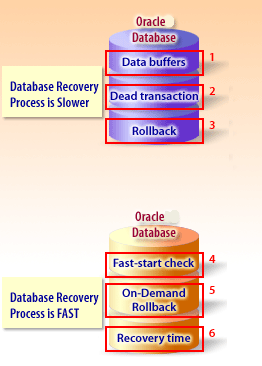Fast-start fault Recovery Components in Oracle

| Data buffers | All the data buffers have to be read during recovery. |
| Dead transactions | All the dead transactions have to be recovered during recovery. |
| Rollback phase | Fast-Start Checkpointing reduces the number of data buffers to be read, reducing the recovery time. |
| Fast-Start Checkpointing | The unique name of the table the index will be based on. |
| ON-DEMAND ROLLBACK | On-Demand Rollback reduces recovery time by recovering dead transactions as required by new transactions. |
| PARALLEL ROLLBACK | Recovery time is reduced by Parallel Rollback, as multiple server processes roll back the transactions. |
Fast-Start Fault Recovery is a feature of Oracle Database that helps to reduce the time required to recover from a system crash or other unplanned outage.
Fast-Start Fault Recovery works by automatically checkpointing the database's data files in the background. This means that when the database crashes, it will restart quickly from the last checkpoint, rather than having to redo all of the transactions that have occurred since the last backup. It is available in all Oracle Database releases since Oracle Database 11g Release 2. Here are some of the benefits of using Fast-Start Fault Recovery:
If you are not already using Fast-Start Fault Recovery, I encourage you to enable it. It is a valuable feature that can help to improve the availability and performance of your Oracle Database. Here are the steps on how to enable Fast-Start Fault Recovery:
Fast-Start Fault Recovery will now be enabled. The database will automatically checkpoint its data files in the background.
Fast-Start Fault Recovery works by automatically checkpointing the database's data files in the background. This means that when the database crashes, it will restart quickly from the last checkpoint, rather than having to redo all of the transactions that have occurred since the last backup. It is available in all Oracle Database releases since Oracle Database 11g Release 2. Here are some of the benefits of using Fast-Start Fault Recovery:
- Reduced recovery time: Fast-Start Fault Recovery can significantly reduce the time required to recover from a system crash or other unplanned outage.
- Improved availability: Fast-Start Fault Recovery can help to improve the availability of your Oracle Database by reducing the amount of downtime that occurs after an unplanned outage.
- Reduced administrative overhead: Fast-Start Fault Recovery is a self-tuning feature, so there is no need for you to manually configure it.
If you are not already using Fast-Start Fault Recovery, I encourage you to enable it. It is a valuable feature that can help to improve the availability and performance of your Oracle Database. Here are the steps on how to enable Fast-Start Fault Recovery:
- Connect to your Oracle Database as a user with SYSDBA privileges.
- Issue the following command:
ALTER SYSTEM SET FAST_START_MTTR_TARGET = 0;
- Respond to the prompt with the following:
YES
Fast-Start Fault Recovery will now be enabled. The database will automatically checkpoint its data files in the background.